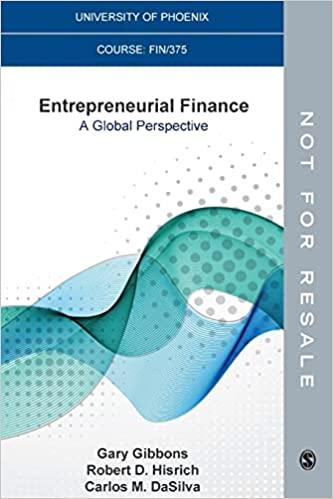Answered step by step
Verified Expert Solution
Question
1 Approved Answer
1.2.1. We are a risk-neutral seller of a given service, whose provision requires a preliminary investment in productive capacity. The WTP of each potential customer

 1.2.1. We are a risk-neutral seller of a given service, whose provision requires a preliminary investment in productive capacity. The WTP of each potential customer is equal to SEK 100 . The probability qx that exactly x customers will be willing to purchase the service, for each x=0,,7, is reported in Table 1 . The cost of each unit of capacity is equal to SEK 30. What is the capacity level that maximises our expected profit, and what is the maximised expected profit? TABLE 1 . The probability qx that exactly x customers will be willing to purchase the service offered by our firm, for all possible values of x. 1.2.2. Let us suppose that the seller can build k units of capacity before the arrival of the customers, at the unit cost of SEK 30. However, unlike in 1.2.1, the production structure is "flexible:" If the number of customers x is greater than k, the seller can still serve each customers in excess at the cost of SEK 45.1 What is the default capacity level that maximises the expected profit, and what is the maximised expected profit? Hint. The key question to be addressed for the optimal capacity choice, both in 1.2.1 and in 1.2.2, is: Does the expected gain from each additional unit of (default) capacity justify bearing the cost of SEK 30? In 1.2.1, the gain is measured by the probability that the capacity unit will actually be used multiplied by the price. In 1.2 .2 , the gain is measured by the same probability multiplied by the cost of the extra-capacity unit needed if the default capacity is insufficient; if we compare the revenue per customer served with/without sufficient default capacity, we have in fact SEK 100(10045)= SEK 45. Remark. Using k to denote the optimal capacity found in 1.2 .1 , we can express the corresponding expected profit as =q11100++qk1(k1)100scenariaswithslackcapacity+(qk++qn)k100scenarioswithnoslackcapacityk30. Similarly, using k" to denote the optimal "default" capacity, we can write the maximised expected profit in 1.2 .2 as =q11100++qkk100scenariascoveredbythedefualtcapacity+qk+1(k+1)(10045)++qnn(10045)scenariaswherebyadditionalcapacityunitsarenecessaryk30. The "incremental" approach behind the expression in (4), in the main handout, can also be used in this case. In 1.2.2, the expression would yield the additional payoff that can be obtained by installing some default capacity, as opposed to buying all the necessary capacity at SEK 45 per unit and thereby realising the "baseline" payoff B=q11(10045)++qnn(10045)
1.2.1. We are a risk-neutral seller of a given service, whose provision requires a preliminary investment in productive capacity. The WTP of each potential customer is equal to SEK 100 . The probability qx that exactly x customers will be willing to purchase the service, for each x=0,,7, is reported in Table 1 . The cost of each unit of capacity is equal to SEK 30. What is the capacity level that maximises our expected profit, and what is the maximised expected profit? TABLE 1 . The probability qx that exactly x customers will be willing to purchase the service offered by our firm, for all possible values of x. 1.2.2. Let us suppose that the seller can build k units of capacity before the arrival of the customers, at the unit cost of SEK 30. However, unlike in 1.2.1, the production structure is "flexible:" If the number of customers x is greater than k, the seller can still serve each customers in excess at the cost of SEK 45.1 What is the default capacity level that maximises the expected profit, and what is the maximised expected profit? Hint. The key question to be addressed for the optimal capacity choice, both in 1.2.1 and in 1.2.2, is: Does the expected gain from each additional unit of (default) capacity justify bearing the cost of SEK 30? In 1.2.1, the gain is measured by the probability that the capacity unit will actually be used multiplied by the price. In 1.2 .2 , the gain is measured by the same probability multiplied by the cost of the extra-capacity unit needed if the default capacity is insufficient; if we compare the revenue per customer served with/without sufficient default capacity, we have in fact SEK 100(10045)= SEK 45. Remark. Using k to denote the optimal capacity found in 1.2 .1 , we can express the corresponding expected profit as =q11100++qk1(k1)100scenariaswithslackcapacity+(qk++qn)k100scenarioswithnoslackcapacityk30. Similarly, using k" to denote the optimal "default" capacity, we can write the maximised expected profit in 1.2 .2 as =q11100++qkk100scenariascoveredbythedefualtcapacity+qk+1(k+1)(10045)++qnn(10045)scenariaswherebyadditionalcapacityunitsarenecessaryk30. The "incremental" approach behind the expression in (4), in the main handout, can also be used in this case. In 1.2.2, the expression would yield the additional payoff that can be obtained by installing some default capacity, as opposed to buying all the necessary capacity at SEK 45 per unit and thereby realising the "baseline" payoff B=q11(10045)++qnn(10045) Step by Step Solution
There are 3 Steps involved in it
Step: 1

Get Instant Access to Expert-Tailored Solutions
See step-by-step solutions with expert insights and AI powered tools for academic success
Step: 2

Step: 3

Ace Your Homework with AI
Get the answers you need in no time with our AI-driven, step-by-step assistance
Get Started


